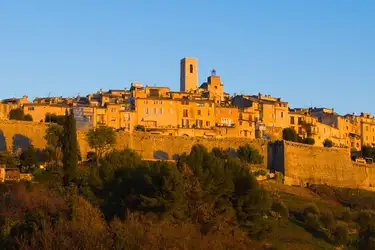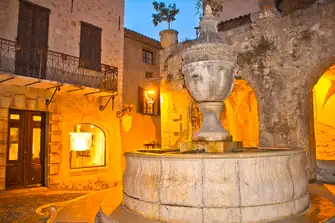 Burgess 50: Our top five social posts in 2025
Burgess 50: Our top five social posts in 2025

The historical side of the French Riviera
Published 22 February 2021
Among the modern glitz and glamour that oozes from the seaside hotspots of the French Riviera are the equally captivating historic villages in the hinterland. Combining the allure of centuries old architecture with panoramic views of the coastline and mountains around, these charming hilltop villages are one of the most popular attractions to explore during a South of France superyacht charter.
Most of these medieval villages first emerged during the 12th and 13th centuries, when French peasants fled from the coastal towns to the hilltops to protect themselves from marauding pirates landing on the shores below. Crumbling through the centuries, in more recent times these villages have been frequented by iconic artists and renovated by artisans inspired by their beauty and charm. Today they are a welcome antidote to the hubbub of the coastal towns and provide a complementary diversion while cruising the iconic cruising grounds of the Côte d’Azur.
Eze

Cruise from Monaco towards Nice and drop anchor in the bay of Eze sur Mer. From here it’s just a short drive to the nearby medieval village of Eze, located just above her sea-level cousin. Sitting at an altitude of 427m and still on the coast, the panoramic vistas over the Riviera and your yacht at anchor below are well worth the precipitous uphill climb (make sure the weather is perfectly clear if you want to appreciate the views). Ancient Phoenician traders once occupied the village and dedicated a temple to the Egyptian goddess of Isis, from which the curious name Eze is apparently derived.
The medieval ramparts that once encircled Eze are unfortunately long gone now, but the cobblestoned streets of the Old Town remain, along with two world famous perfume factories, Galimard and Fragonard, and two of the most celebrated restaurants in the region. First the dining room of the two-Michelin star La Chèvre d’Or is a gastronomic mecca, with a reputation for both its spectacular setting and celebrated cuisine. Located in a château in Eze itself, meals here can be enjoyed either on the terrace or in the garden. But for an even more dramatic vista and equally elegant local cuisine, climb the cobblestone path to Château Eza, located atop the medieval village of Eze. The dining terrace here actually hangs over the cliff, some 400 meters above sea level, and is genuinely spectacular.
Saint-Paul de Vence

Less than an hour’s drive from Antibes through the Provençal countryside, Saint-Paul de Vence is as picture-perfect an ancient hilltop village as you can get. Prized by artists and writers since the 1940s for its unique light qualities, the medieval fortified village still has an arty vibe and is chock full of art galleries.
After exploring the village and its art heritage, why not make a pit stop for lunch or dinner on the fig tree shaded patio of the legendary La Colombe d’Or, and dine on family-style cuisine in their shaded courtyard, surrounded by works of art by Matisse and Picasso, both of whom spent time here. The authentic works of art on display were actually given by the artists to the owners as payment in kind for their meals. Alternatively, hidden away on a winding cobblestone street above the stone ramparts, the restaurant Le Saint Paul is also ideal for an intimate starlit dinner on the flower-lined terrace.
Gourdon

Set on a clifftop, the approach to the gothic style village of Gourdon is as impressive as the village itself. Flanked by a 12th-century castle built into the rock face overhanging the Vallée du Loup (which translates as Wolf’s Valley), the village is reached via a winding road that snakes its way via switch backs to the top of the mountain, and is hugely popular with both cyclists and motorcyclists alike, especially at the weekend. Here you will again be rewarded with panoramic views, and a pretty medieval village with shops selling homemade delicacies. The castle, which today houses a number of museums, was built in the 12th-century and restored in the 17th-century and is surrounded by gardens that were designed by Le Notre, the same architect who was behind the gardens of the Palace of Versailles.
Mougins

Just a ten minute drive from Cannes, the pretty hilltop village of Mougins is the perfect spot for a long lunch away from the coast. Surrounded by 14th century ramparts, Mougins was home to Picasso (during his latter years) and also Yves St Laurent, along with many other famed artists and artisans. Today it is probably best known for the many art galleries and gourmet restaurants that fill the pretty pedestrianised alleyways and the main square. Reserve a table at La Place de Mougins for Michelin-star seasonal cuisine right on the square. Alternatively, head out of town to Le Bistrot du Mas, also with a Michelin-star, and dine on their terrace, shaded by pine trees and with views over the hillsides of Mougins.
Grasse

The fields surrounding the hilltop village of Grasse boast a confluence of soil, sun and temperature that has been nurturing roses and jasmine since the 17th Century, helping to make this little town quite literally the perfume capital of the world. However, it wasn’t always so. In medieval times the town thrived in leather production, but the tanning process made a foul odor that the gentry were not pleased with. But when the Queen of France, Catherine de Medici, was presented with a pair of scented gloves by a tanner from the town a new industry was born based around fragrance, and so the perfume trade began. Still the spiritual centre of the perfume industry today, these days several major fragrance houses still grow May roses and jasmine in the flower fields surrounding the town, while within the ramparts of the old town fragranced lotions and potions spill out onto the cobblestone streets, and visitors can even have their own custom made perfume fabricated for them on the spot. Afterwards take a stroll through the ancient lanes of the town before heading to the Michelin-star restaurant at La Bastide Saint-Antoine for regional delicacies.
There are more than 120 villages scattered in the hills in the Côte d’Azur province. Many are conveniently close to the Riviera and can easily be visited on a charter itinerary through the cruising grounds of the Côte d’Azur.
To find out more about Burgess’ yachts for sale and yachts for charter, please contact a Burgess broker. Alternatively, get in touch with one of our offices directly: London, Monaco, New York, Miami, Singapore or all other locations.
 Catamaran GOOD DAY SUNSHINE sold
Catamaran GOOD DAY SUNSHINE sold
 Last minute winter charter destinations
Last minute winter charter destinations

